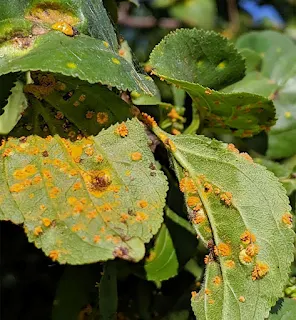Memorial Day weekend is traditionally the first weekend for a summer BBQ and the first sightings of tan spot in wheat. I consider tan spot the 'canary in the coal mine' to signal the start of the disease season in small grains. This year was no exception, even if most spring seeded wheat has yet to emerge. In this case, there was plenty of tan spot on one of the entries in the winter wheat variety trial at the NWROC (Photo 1). The disease models for tan spot show indeed about 50% of the last ten days to two weeks to have been favorable infections. It has generally been a little too cool yet for the Septoria species, leaf rust of wheat, crown rust of oats, or Fusarium head blight (FHB).
I encourage you to scout your winter wheat and determine how high into the canopy the tan spot has progressed up to in relation to the stage of the crop. If the situation is like in the picture below, with lesions clearly near the top of the canopy and the crop not yet having reached the boot stage, it is time to use a fungicide sooner rather than later and no later than Feekes 9. If there are just a few lesions in the bottom you may be able to delay the application to Feekes 10.51 and combine the control of tan spot with the control/protection against the other economically important fungal diseases (leaf rust, FHB).
 |
| Photo - Tan spot in winter wheat |
Buckthorn is the alternate host of crown rust of oats. This is the time of year you will start to find aecia on the underside of buckthorn leaves (Photo 2). Those aecia will produce the spores that infect the oats and cause crown rust. If you have some time, I encourage you to find some buckthorn and see whether they have these bright orange aecia on the underside of the leaves. If you find plenty near your oat fields, it means that you will keep a close eye on your oats.
 |
| Photo 2 - Aecia of crown rust on buckthorn |
Finally, Bruce Potter found both English grain and bird cherry-oat aphids in the winter rye and winter wheat variety trials at the SWROC near Lamberton, MN. There have been plenty of southerly wind events in recent weeks. Now is the time to scout for aphids to determine whether you are at the economic threshold for aphids (>80% of stems having one or more aphids present) if you have winter rye that is starting to head and winter wheat that is reaching the late boot stage as the window to economically control the aphids closes once the crop has fully headed.
Comments
Post a Comment